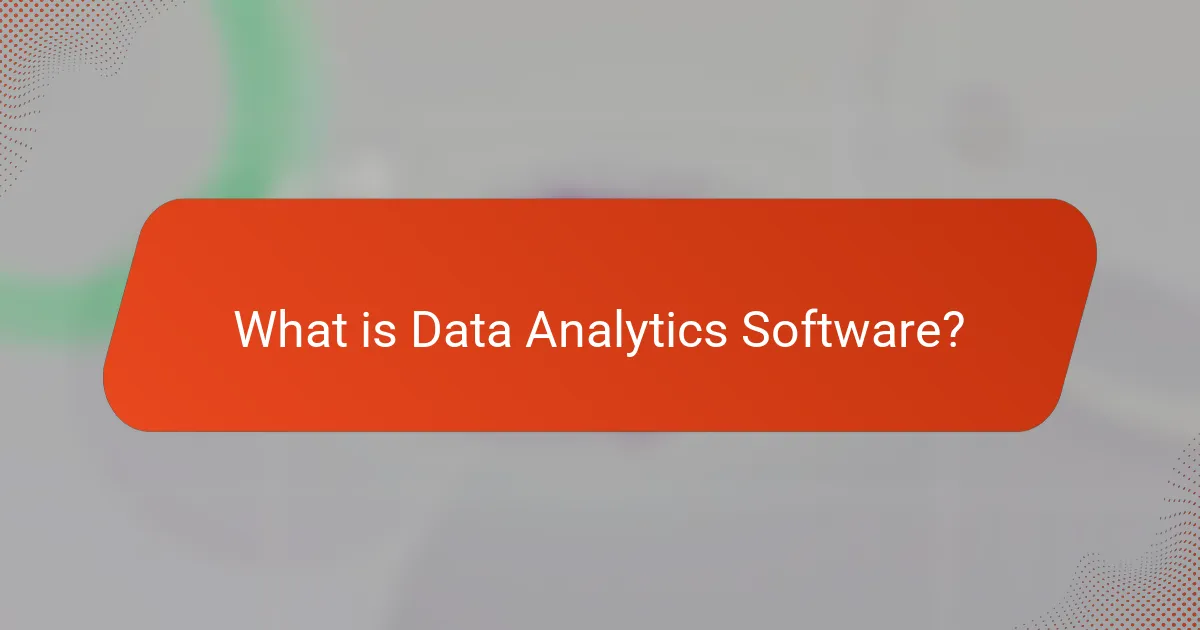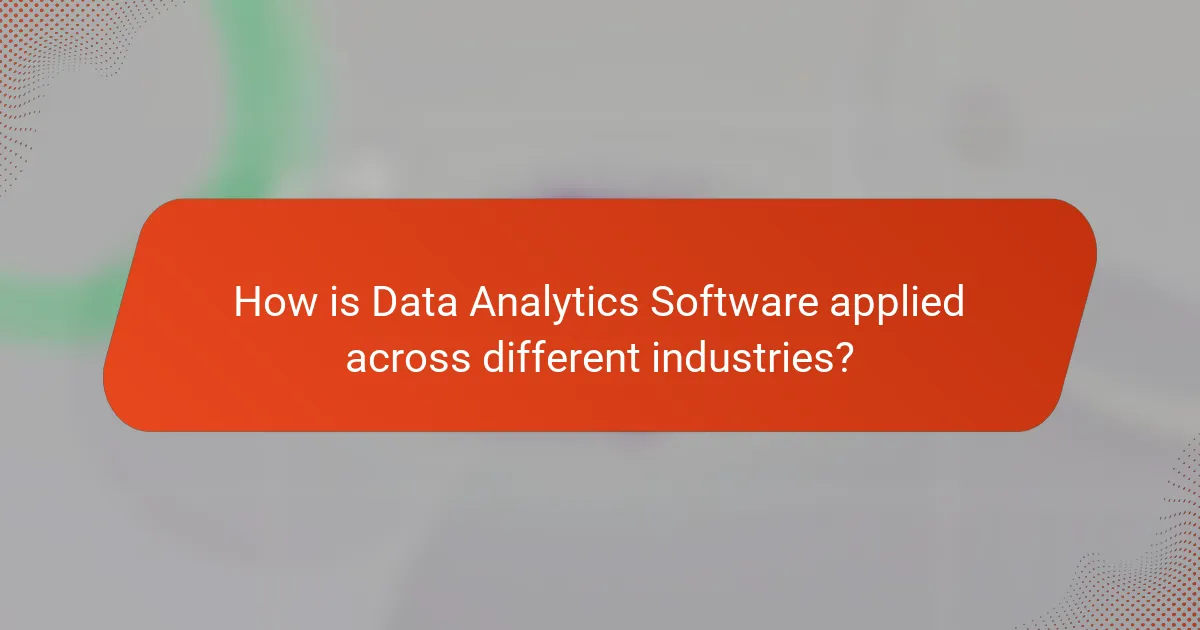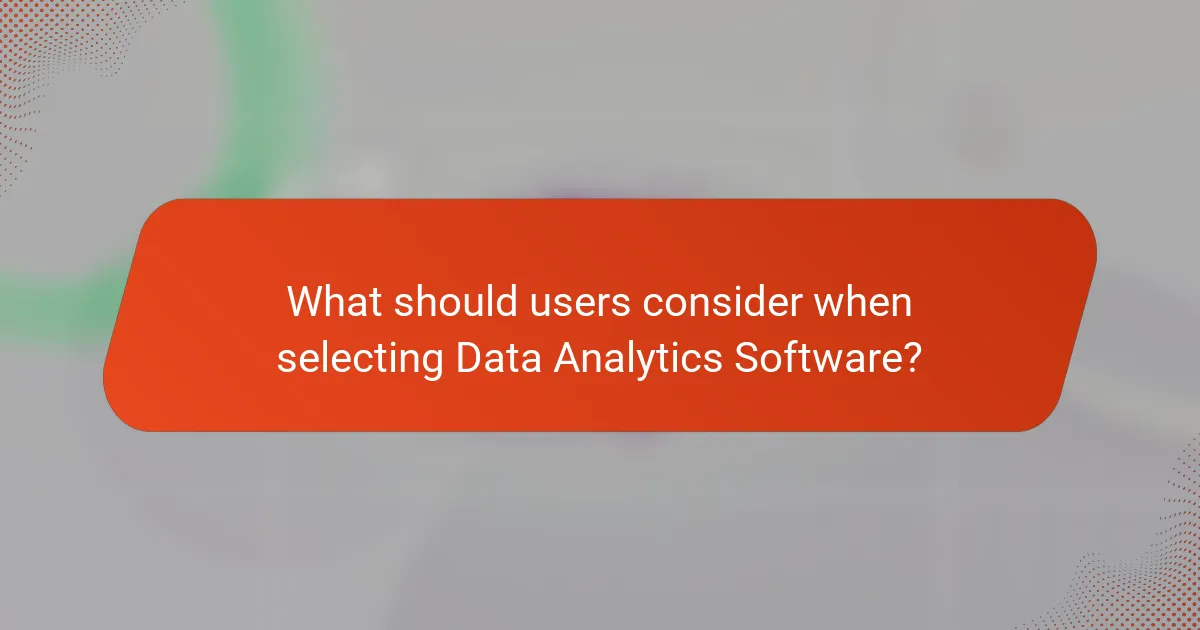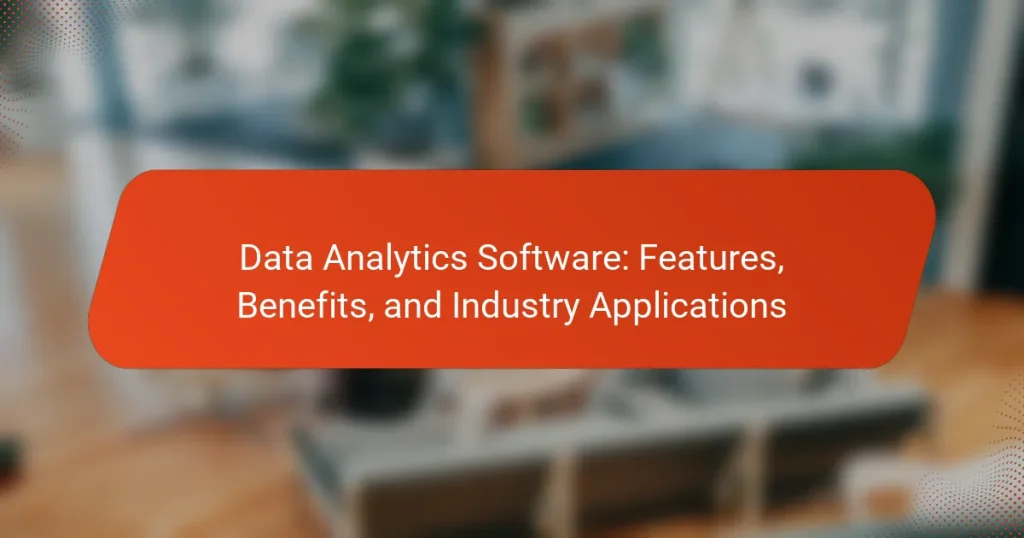Data analytics software is a crucial tool for organizations seeking to collect, process, and analyze data effectively. This software enhances decision-making through features such as data visualization, statistical analysis, and reporting, accommodating large datasets from diverse sources. Its applications span multiple industries, including healthcare, retail, finance, manufacturing, telecommunications, and marketing, demonstrating its versatility in improving operational efficiency and effectiveness. When selecting data analytics software, users should evaluate factors like ease of use, scalability, integration capabilities, cost-effectiveness, data visualization features, security measures, and customer support to ensure optimal performance and alignment with organizational needs.

What is Data Analytics Software?
Data analytics software is a tool that enables the collection, processing, and analysis of data. It helps organizations make informed decisions based on insights derived from data. This software typically includes features for data visualization, statistical analysis, and reporting. It can handle large volumes of data from various sources, including databases and spreadsheets. Popular examples include Tableau, Microsoft Power BI, and SAS. According to a report by Gartner, the global data analytics market is projected to reach $274 billion by 2022, highlighting its significance in modern business practices.
How does Data Analytics Software function?
Data analytics software functions by collecting, processing, and analyzing data to extract actionable insights. It integrates various data sources, such as databases and APIs, to gather relevant information. The software then employs statistical methods and algorithms to interpret the data. Visualization tools present the findings in an understandable format, such as graphs or dashboards. Users can interact with these visualizations to explore trends and patterns. Additionally, the software often includes reporting features for summarizing insights. This functionality supports decision-making across various industries. Data analytics software enhances operational efficiency and drives strategic growth.
What are the key components of Data Analytics Software?
The key components of Data Analytics Software include data integration, data processing, data visualization, and reporting tools. Data integration allows for the collection and combination of data from various sources. Data processing transforms raw data into a usable format through cleaning and preparation. Data visualization enables users to create graphical representations of data for easier interpretation. Reporting tools generate structured summaries of data insights. These components work together to facilitate effective data analysis and decision-making.
How do these components interact to provide insights?
Data analytics software components interact by collecting, processing, and analyzing data to generate insights. Data collection involves gathering raw data from various sources. This data is then stored in a database for easy access. Data processing transforms raw data into a structured format. This structured data is analyzed using algorithms and statistical methods. The analysis reveals patterns and trends within the data. Visualization tools present these findings in an understandable format. This interaction enables organizations to make informed decisions based on data-driven insights.
What are the primary features of Data Analytics Software?
Data analytics software typically includes features such as data visualization, statistical analysis, and data mining. Data visualization tools allow users to create graphs and charts for better insights. Statistical analysis features help in understanding data trends and patterns. Data mining capabilities enable the extraction of valuable information from large datasets. Additionally, reporting tools automate the generation of reports for stakeholders. Integration with other systems is also a key feature, facilitating data import and export. User-friendly interfaces enhance accessibility for non-technical users. Finally, real-time analytics provide immediate insights for timely decision-making.
Which data visualization tools are commonly included?
Commonly included data visualization tools are Tableau, Power BI, and QlikView. Tableau is known for its interactive dashboards and user-friendly interface. Power BI integrates seamlessly with Microsoft products, enhancing data analysis capabilities. QlikView offers associative data modeling, allowing users to explore data freely. Other notable tools include Google Data Studio and D3.js. Google Data Studio is free and provides real-time collaboration features. D3.js is a JavaScript library for creating custom visualizations. These tools are widely used across industries for effective data representation.
How do data integration capabilities enhance functionality?
Data integration capabilities enhance functionality by enabling seamless data flow between disparate systems. This allows organizations to consolidate data from various sources into a unified view. With integrated data, businesses can make informed decisions based on comprehensive insights. Enhanced functionality also includes improved data accuracy and consistency. This reduces errors that may arise from manual data entry. Furthermore, data integration supports real-time analytics, allowing for timely responses to market changes. According to a report by Gartner, organizations that leverage data integration see a 30% increase in operational efficiency. Thus, effective data integration is crucial for maximizing the value of data analytics software.
What benefits does Data Analytics Software provide to organizations?
Data Analytics Software provides organizations with improved decision-making capabilities. It enables businesses to analyze large volumes of data efficiently. This software identifies trends and patterns that inform strategic planning. Organizations can enhance operational efficiency through data-driven insights. It also supports predictive analytics, allowing businesses to forecast future outcomes. Moreover, data analytics fosters better customer understanding and personalization. Companies can optimize marketing strategies based on data insights. According to a McKinsey report, organizations that leverage data analytics can increase productivity by up to 20%.
How does it improve decision-making processes?
Data analytics software improves decision-making processes by providing data-driven insights. It analyzes large datasets to identify trends and patterns. These insights help organizations make informed choices. For example, a study by McKinsey found that companies using data analytics are 23 times more likely to acquire customers. Additionally, data analytics enhances predictive capabilities, allowing businesses to forecast outcomes effectively. This leads to more strategic planning and resource allocation. Organizations can also assess risks better through data analysis. By leveraging real-time data, decision-makers can respond swiftly to market changes. Overall, data analytics transforms raw data into actionable information for improved decision-making.
What cost savings can organizations expect from using it?
Organizations can expect significant cost savings from using data analytics software. This software enhances operational efficiency by streamlining processes. It reduces the time spent on manual data handling and reporting. Automating these tasks can lead to labor cost reductions. According to a study by McKinsey, data-driven organizations can improve productivity by up to 20%. Enhanced decision-making capabilities minimize costly errors and inefficiencies. Furthermore, predictive analytics can optimize inventory management and reduce excess stock costs. Overall, the financial benefits from improved data utilization can lead to substantial savings for organizations.

How is Data Analytics Software applied across different industries?
Data analytics software is utilized across various industries to enhance decision-making and operational efficiency. In healthcare, it analyzes patient data to improve treatment outcomes and reduce costs. Retailers utilize it for inventory management and customer behavior analysis. Financial services employ data analytics for risk assessment and fraud detection. Manufacturing industries use it to optimize supply chain management and predictive maintenance. In telecommunications, it helps in customer segmentation and churn prediction. Marketing teams leverage data analytics to measure campaign effectiveness and target audiences more accurately. Each application demonstrates the software’s versatility and impact on industry performance.
What industries utilize Data Analytics Software the most?
The industries that utilize Data Analytics Software the most include healthcare, finance, retail, and manufacturing. In healthcare, data analytics enhances patient care and operational efficiency. The finance sector uses analytics for risk management and fraud detection. Retail leverages data for inventory management and customer insights. Manufacturing employs analytics to optimize production processes and supply chains. According to a 2022 report by McKinsey, 60% of companies in these industries have adopted data analytics to drive decision-making.
How does the software support retail businesses?
Software supports retail businesses by providing data analytics tools that enhance decision-making. It enables retailers to analyze customer behavior and preferences. This analysis helps in inventory management and optimizing stock levels. Retailers can forecast sales trends based on historical data. The software also aids in targeted marketing campaigns by segmenting customer data. Additionally, it improves operational efficiency through performance tracking. According to a report by McKinsey, data-driven retailers outperform their competitors by 20%. This demonstrates the significant impact of software on retail success.
What role does it play in healthcare analytics?
Data analytics software plays a crucial role in healthcare analytics. It enables the collection, processing, and analysis of vast amounts of healthcare data. This software helps identify trends and patterns in patient outcomes. It supports decision-making by providing insights based on real-time data. Additionally, it enhances operational efficiency by streamlining workflows. Healthcare organizations utilize it to improve patient care and reduce costs. According to a report by the Healthcare Information and Management Systems Society, data analytics can reduce hospital readmissions by up to 20%. This demonstrates the software’s significant impact on healthcare outcomes.
What are some unique applications of Data Analytics Software?
Data analytics software has unique applications across various industries. In healthcare, it predicts patient outcomes and optimizes treatment plans. Retail businesses utilize it for inventory management and personalized marketing strategies. Financial institutions apply data analytics for fraud detection and risk management. In manufacturing, it enhances supply chain efficiency and predictive maintenance. Sports teams analyze player performance and fan engagement through data insights. Education institutions leverage it to improve student learning outcomes and operational efficiency. Transportation companies optimize routes and logistics using data analytics. These applications demonstrate the versatility and impact of data analytics software in diverse fields.
How is Data Analytics Software transforming marketing strategies?
Data analytics software is transforming marketing strategies by enabling data-driven decision-making. It allows marketers to analyze consumer behavior and preferences. This software processes vast amounts of data quickly and accurately. As a result, businesses can target their audiences more effectively. Personalized marketing campaigns lead to higher engagement rates. According to a study by McKinsey, data-driven organizations outperform their peers by 20% in profitability. Additionally, real-time analytics help marketers adjust strategies on the fly. This adaptability enhances campaign performance and ROI. Overall, data analytics software is essential for modern marketing success.
What innovative uses are emerging in the finance sector?
Emerging innovative uses in the finance sector include advanced data analytics, blockchain technology, and artificial intelligence. Data analytics software is being utilized to enhance decision-making processes. Financial institutions leverage predictive analytics for risk assessment and fraud detection. Blockchain technology is revolutionizing payment systems and transaction transparency. Artificial intelligence is automating customer service through chatbots and personalized financial advice. Additionally, machine learning algorithms identify investment opportunities by analyzing market trends. These innovations improve operational efficiency and customer experience in finance. According to a Deloitte report, 75% of financial services firms are investing in AI for enhanced data analytics capabilities.

What should users consider when selecting Data Analytics Software?
Users should consider several key factors when selecting data analytics software. The software’s ease of use is crucial for adoption by team members. Scalability ensures the software can grow with the organization’s needs. Integration capabilities with existing systems streamline data workflows. Cost-effectiveness is vital for budget management. Data visualization features enhance the interpretation of analytics results. Security measures protect sensitive information from breaches. Customer support availability aids in troubleshooting and user training. Lastly, the software’s ability to handle various data types increases its versatility.
What factors influence the choice of Data Analytics Software?
The choice of Data Analytics Software is influenced by several key factors. These factors include the software’s functionality, scalability, and user-friendliness. Functionality pertains to the specific analytical capabilities offered, such as data visualization, predictive analytics, and machine learning integration. Scalability refers to the software’s ability to handle increasing data volumes and user demands over time. User-friendliness is crucial for ensuring that team members can effectively utilize the software without extensive training.
Cost also plays a significant role in the decision-making process. Organizations often evaluate the total cost of ownership, which includes licensing fees, maintenance costs, and potential hidden expenses. Compatibility with existing systems is another important factor. The software must seamlessly integrate with current data sources and tools to avoid disruptions.
Vendor support and reputation can influence the choice as well. A vendor with a strong track record in customer service and product reliability can provide peace of mind. Additionally, the availability of community resources and training materials can enhance the software’s usability.
Finally, industry-specific requirements may dictate the choice of software. Certain sectors, such as finance or healthcare, may require compliance with specific regulations that certain analytics tools can better accommodate.
How important is user-friendliness in software selection?
User-friendliness is critical in software selection. It directly impacts user adoption and productivity. A user-friendly interface reduces the learning curve for new users. According to a study by the Nielsen Norman Group, users are 50% more likely to use software that is easy to navigate. Additionally, user-friendly software can minimize errors and enhance overall efficiency. In data analytics, intuitive design allows users to focus on insights rather than struggling with the tool. Therefore, prioritizing user-friendliness can lead to better outcomes in software implementation.
What role does scalability play in the decision-making process?
Scalability is crucial in the decision-making process as it determines a system’s ability to handle growth. When organizations choose data analytics software, they must consider scalability to ensure it can accommodate increasing data volumes. A scalable system allows for seamless integration of additional resources without compromising performance. This capability is vital for businesses anticipating future expansion or fluctuating workloads. According to a study by Gartner, 70% of organizations cite scalability as a key factor in their software selection process. This statistic underscores the importance of scalability in making informed, strategic decisions.
What are best practices for implementing Data Analytics Software?
Best practices for implementing Data Analytics Software include defining clear objectives and aligning them with business goals. Organizations should assess their data quality and ensure it meets analytical needs. Selecting the right software that fits the organization’s requirements is crucial. Training staff on the software is essential for effective utilization. Establishing a data governance framework enhances data management practices. Regularly reviewing and updating analytics strategies keeps them relevant. According to a study by Gartner, organizations that prioritize these practices see a 20% increase in data-driven decision-making effectiveness.
How can organizations ensure successful integration with existing systems?
Organizations can ensure successful integration with existing systems by conducting thorough assessments of current infrastructure. They should evaluate compatibility between new and existing systems. Effective planning is essential for identifying potential challenges. Organizations must involve stakeholders early in the integration process. Clear communication facilitates alignment on goals and expectations. Utilizing standardized protocols can streamline data exchange. Testing integrations in a controlled environment helps identify issues before full deployment. Regular monitoring post-integration ensures sustained functionality and performance.
What training resources are available for users?
Training resources available for users include online courses, webinars, and documentation. Online courses offer structured learning paths and can be found on platforms like Coursera and Udacity. Webinars provide live training sessions led by experts in the field. Documentation includes user manuals and FAQs that guide users through software features. Additionally, many software providers offer community forums for peer support. These resources facilitate user understanding and proficiency in data analytics software.
What common challenges do organizations face with Data Analytics Software?
Organizations face several common challenges with data analytics software. Data quality is a significant issue. Poor data quality can lead to inaccurate insights. Integration with existing systems often proves complex. Many organizations struggle to combine data from various sources. User adoption is another challenge. Employees may resist using new tools due to lack of training. Additionally, organizations often face high costs associated with implementation and maintenance. Budget constraints can limit access to advanced analytics features. Lastly, ensuring data security and compliance is critical. Organizations must navigate regulations while utilizing data analytics effectively.
How can data quality issues impact analytics outcomes?
Data quality issues can significantly impact analytics outcomes by leading to inaccurate insights. Poor data quality can result from incomplete, outdated, or erroneous data. Such inaccuracies can skew analysis and misinform decision-making processes. For instance, a study by Gartner found that organizations lose an average of $15 million annually due to poor data quality. This loss can stem from misguided strategies based on flawed analytics. Furthermore, data quality issues can diminish trust in analytics results among stakeholders. Ultimately, reliable analytics requires high-quality data to ensure valid and actionable outcomes.
What are some strategies for overcoming resistance to adoption?
To overcome resistance to adoption, organizations can implement several strategies. First, they should provide comprehensive training to users. Training enhances user confidence and familiarity with the software. Second, involving key stakeholders early in the process fosters buy-in. Stakeholders can voice concerns and contribute to solutions. Third, demonstrating tangible benefits through pilot programs can showcase value. Successful case studies help alleviate fears about the software’s effectiveness. Fourth, addressing concerns transparently builds trust. Open communication about challenges and solutions encourages acceptance. Lastly, offering ongoing support ensures users feel assisted throughout the transition. Research indicates that effective change management increases adoption rates significantly, highlighting the importance of these strategies.
Data analytics software is a crucial tool for organizations, enabling the collection, processing, and analysis of data to support informed decision-making. The article covers the key components, features, and functionalities of data analytics software, including data visualization, statistical analysis, and reporting tools. It also explores the benefits of using such software across various industries, highlighting its role in enhancing operational efficiency and improving decision-making processes. Additionally, the article addresses considerations for selecting data analytics software and common challenges organizations face during implementation.




